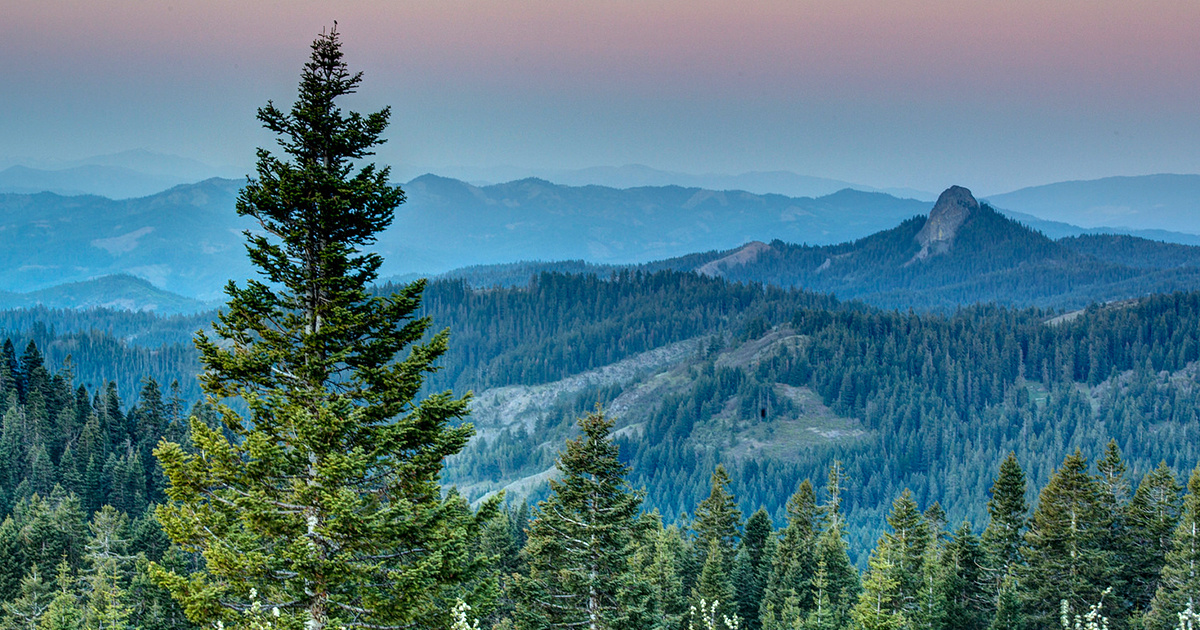
Zinke Calls for Reducing Two More National Monuments, Exposing Public Lands to Grazing and Logging

A view from Cascade-Siskiyou National Monument—Pilot Rock. BLM / Bob Wick / Flickr
By Jason Mark
More than three months after he delivered his national monument recommendations to the White House, Interior Sec. Ryan Zinke on Tuesday finally made public his list of proposed reductions and management changes to 10 monuments. The announcement came one day after President Donald Trump, in the largest rollback of protected areas in U.S. history, signed a pair of proclamations slashing the size of Bears Ears National Monument and Grand Staircase–Escalante National Monument.
Zinke’s final report to the president is largely identical to a version of the recommendations that was leaked to the Washington Post and the Wall Street Journal in September.
In addition to the reductions in the two Utah monuments Trump announced Monday, Zinke is urging unspecified reductions in Nevada’s Gold Butte National Monument and Cascade-Siskiyou National Monument, which straddles the California-Oregon border. The report also urges the president to consider changing the boundaries of two marine monuments in the Pacific Ocean: Pacific Remote Islands and Rose Atoll.
Conservation groups and some elected officials quickly criticized Zinke’s recommendations. “Secretary Zinke falsely claims the Interior Department is listening to the voices of Oregonians when it comes to the agency’s damaging, vague recommendation to close off public access to the Cascade-Siskiyou monument,” Sen. Ron Wyden, an Oregon Democrat and an outspoken proponent of the Cascade-Siskiyou National Monument, said. “This is not what the majority of Oregonians signed up for when they spoke out in favor of expanding protections for this Oregon treasure. These public lands belong to all Oregonians and all Americans, not to corporations or Trump’s department heads.”
Environmental organizations, led by several southwestern Native American nations, are already moving to block Trump’s national monument reductions, which they say are illegal.
“Yesterday, we saw the largest ever stripping of protections for America’s publicly owned lands, with losses at two national monuments in Utah,” Jamie Williams, president of the Wilderness Society, said Tuesday. “Today, President Trump and Secretary Zinke are doubling down on their illegal and unpopular attack on public lands and waters by proposing to rip away protections from even more of America’s favorite places in the Nevada desert and the lush forests of Oregon and Northern California.”
Zinke’s report also calls for making changes to the management plans of another half dozen national monuments, including Katahdin Woods and Waters in Maine, Northeast Canyons and Seamounts in the Atlantic Ocean, and New Mexico’s Rio Grande del Norte and Organ Mountains-Desert Peaks. In general, the recommended changes call for allowing additional logging, cattle grazing, and/or the use of off-road motorized vehicles.
On a call Tuesday with reporters, Zinke rejected arguments that the monument reductions are in any way motivated by efforts to increase fossil fuel extraction on public lands. “This is not about energy,” Zinke told reporters. “There is no oil and gas assets.”
Zinke’s official report to the president, however, does note that Trump’s April 2017 executive order asking for the national monument review explicitly raised the issue of energy assets: “Monument designations that result from a lack of public outreach and proper coordination with state, tribal, and local officials and other relevant stakeholders may also create barriers to achieving energy independence, restrict public access to and use of federal lands, burden state, tribal, and local governments, and otherwise curtail economic growth.” The formal review of Grand Staircase–Escalante National Monument notes that the area contains “an estimated several billion tons of coal.”
Zinke’s Monument Review: Another Gift to Oil, Gas, and Coal https://t.co/MosPAvoxju @Sierra_Magazine @greenpeaceusa
— EcoWatch (@EcoWatch) October 3, 2017
During the Tuesday press conference, Zinke also blasted critics who have complained that the monument review process has been one-sided, lacking in transparency, and deaf to public opinion. “I don’t yield to public pressure,” Zinke said. “Sound public policy is not based on the threats of a lawsuit; it’s doing what’s right.”
According to an analysis by the Center for Western Priorities, 98 percent of the 650,000 public comments received by the Interior Department during Zinke’s review process favored preserving national monuments at their current size.
Reposted with permission from our media associate SIERRA magazine.

 233k
233k  41k
41k  Subscribe
Subscribe 